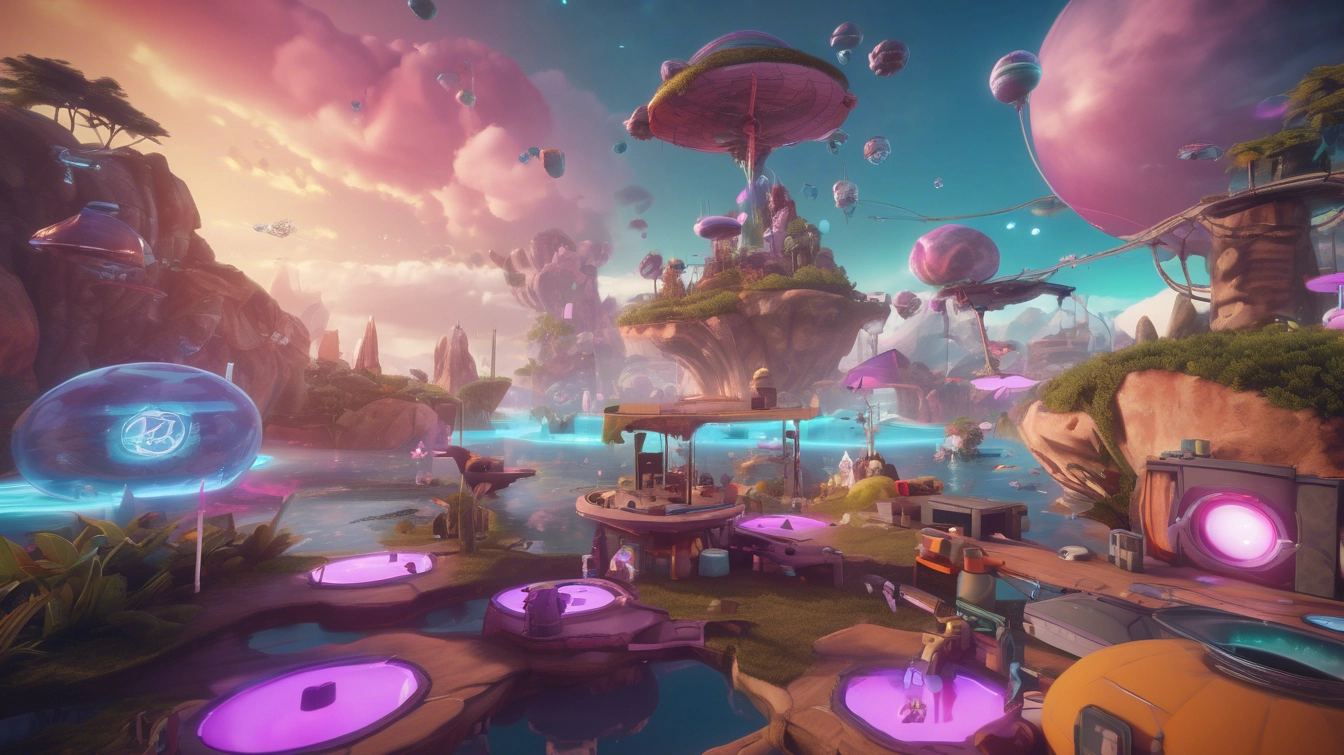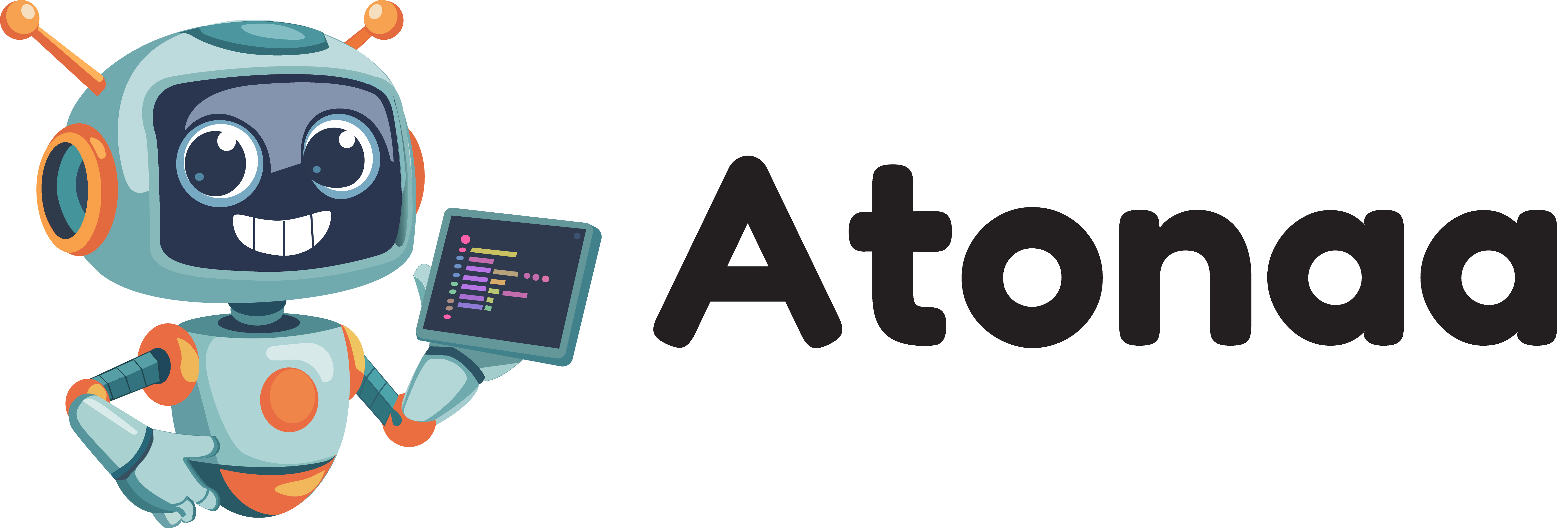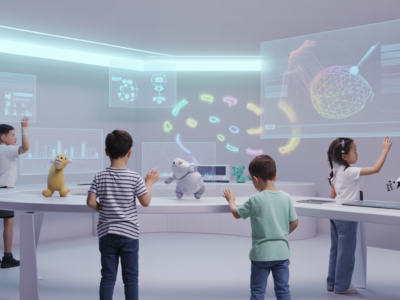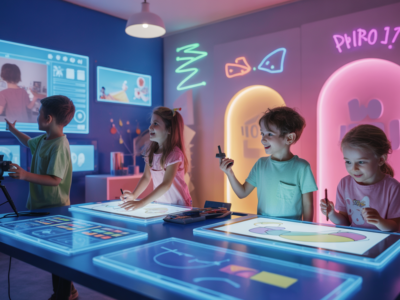Game Development
Game Development

Game Development For Kids
COURSE DESCRIPTION
In this creative technology course, students explore the building blocks of digital media production — from visual design to audio editing and storytelling. Using intuitive creation tools, children produce digital artwork, narrated slideshows, short animations, and multimedia presentations. Learners are introduced to the technical workflow of digital content production including planning, asset creation, sequencing, and final publication. Media ethics, copyright awareness, and design thinking are embedded throughout the course. This pathway develops communication and digital literacy skills, equipping young learners to express their ideas confidently in today’s content-driven world.
Course Prerequisites:
None
LEVEL ONE LEARNING PATH
Game Explorers – Intro to Game Logic
This foundational course introduces young learners to the technical architecture and creative logic of game development, transforming them from passive consumers into early-stage designers and programmers.
In Level 1 of the Game Development path, students begin working with event-driven programming through Scratch — a block-based language developed by MIT that allows children to program interactive games, animations, and stories without writing syntax-heavy code. But while the interface is visual, the thinking is deeply computational.
Through guided challenges and open-ended design prompts, learners explore key computer science concepts such as:
- Sequential execution
- Event handling
- XY-plane coordinate manipulation
- Conditional logic (if-then triggers)
- Iteration using loops
- Basic variable tracking (scores, timers, states)
Students begin building games with real logic structures: moving characters based on input, creating interactive collisions, triggering sounds, animating sprite behavior, and designing cause-effect feedback loops. They develop spatial reasoning and algorithmic problem-solving while gaining a strong sense of ownership over their work.
The course also introduces the game design cycle — ideation, prototyping, user testing, debugging, and presentation — nurturing creativity, persistence, and user-centered thinking. Children will be guided to analyze what makes games fun, how rules affect behavior, and how interaction design shapes the player experience.
Every student will finish this level with a playable game project, a deep understanding of core logic structures, and the confidence to continue creating. They will also begin developing the technical vocabulary and habits of mind foundational to software engineering and digital product development.
Key Learning Objectives:Learning Objectives:
By the end of this level, students will be able to:
- Define the core components of a game: goal, feedback, rules, interaction, and outcomes
- Use Scratch’s block-based programming to control sprite behavior
- Apply control flow logic (sequences, conditionals, loops) in game scenarios
- Implement player input handling using keyboard or mouse events
- Program basic motion, scoring systems, and audio effects
- Understand and manipulate sprite coordinates on the XY-plane
- Create and switch between game scenes using event logic
- Debug common errors in visual programming workflows
- Present and explain the logic behind their game to peers or parents
Key Technical Concepts Introduced:
- Event-driven programming
- Sprite behavior scripting
- Conditional execution (if, if-else)
- Looping (repeat, forever)
- Coordinate-based movement
- User input detection
- State management (score/lives)
- Game UX: visual feedback, pacing, and flow
- Project-based development cycle: design → build → test → share
Level 1: Capstone
By the end of Level 1, each student will design and publish a fully functional mini-game built entirely in Scratch. Games may include scorekeeping, animated character interactions, multiple levels, or win/loss conditions. Final presentations emphasize code logic explanation, peer feedback, and creative storytelling.
LEVEL TWO LEARNING PATH
Advanced Interactive Systems & Visual Programming
In Level 2 of the Game Development path, young learners move beyond foundational mechanics and begin engineering multi-layered interactive systems, applying deeper logic structures and user-experience thinking to build more complex, engaging, and polished games.
Expanding on the event-driven concepts introduced in Level 1, students now dive into multi-scene architecture, modular code reuse, sprite broadcasting, and game state management using Scratch — an industry-standard educational platform that mimics key programming structures found in professional development.
- Player health and inventory tracking
- Level progression and scene transitions
- Custom animations and dialogue sequencing
- Timer-based events and power-up mechanics
- Basic AI behaviors (chasing, random movement, etc.)
They'll also be introduced to debugging methodologies, including structured testing cycles and logic trace techniques, enabling them to iterate and refine their work more independently.
More than just coding, this level emphasizes design thinking, user experience awareness, and narrative integration, allowing students to create games that are not only functional but also fun, coherent, and intuitive for players. By applying storytelling to mechanics and balancing game difficulty through iterative testing, students begin to see themselves as engineers, designers, and storytellers — equipped with the technical vocabulary and mindset of future developers.
The course also introduces the game design cycle — ideation, prototyping, user testing, debugging, and presentation — nurturing creativity, persistence, and user-centered thinking. Children will be guided to analyze what makes games fun, how rules affect behavior, and how interaction design shapes the player experience.
Every student will finish this level with a playable game project, a deep understanding of core logic structures, and the confidence to continue creating. They will also begin developing the technical vocabulary and habits of mind foundational to software engineering and digital product development.
Key Learning Objectives:Learning Objectives
By the end of this level, students will be able to:
- Design multi-stage games with structured progression
- Use broadcast messaging and event triggers to manage transitions and interactions
- Implement game states such as win/loss conditions, player health, and respawns
- Apply custom sprite animations and character switching logic
- Introduce non-player character (NPC) behavior using movement algorithms
- Build user interfaces: menus, instructions, start/restart buttons
- Create and manipulate game variables (e.g., coins, keys, power-ups)
- Test and debug multi-part logic chains
- Present polished, playable games with defined objectives and replayability
Key Technical Concepts Introduced
- Modular game logic and code reuse
- Scene management via broadcast control
- Game states and conditional flow control
- Custom variables for collectibles, stats, and power-ups
- Sprite cloning and enemy AI simulation
- UX/UI considerations (menus, instructions, HUDs)
- Game loop refinement through feedback and debugging cycles
Level 2: Capstone
Each learner will design and develop a multi-level interactive game featuring progression, animated sequences, win/lose outcomes, and a clear narrative or thematic goal. Games will include scoring, power-ups, enemy logic, and UI components. Final presentations will include live gameplay demo, explanation of the game system, and optional peer feedback sessions.
Tools, Languages & Platforms:
- Scratch (MIT): Core programming platform
- Scratch Extensions: Sound and sensor interactions
- Game Design Templates: Custom Atonaa design worksheets
- Paper Prototyping & Storyboards: Logic planning and UI/UX sketching
Technology Requirements:
- A desktop or laptop computer (macOS, Windows, or Chromebook)
- A desktop or laptop computer (macOS, Windows, or Chromebook)
- Access to the latest version of Google Chrome
- A reliable internet connection
- Mouse or trackpad for navigation (touchscreens not ideal)
- Headphones (recommended for focused gameplay testing and sound feedback)
- No downloads required — Scratch runs fully online
Graduation Requirements:
To graduate from Atonaa’s Vanguard Program for ages 5–7, learners must complete Level 1 and 2 with a demonstrated ability to build and present original digital projects, showcasing foundational skills in logic, design, and tool usage relevant to their learning path (e.g., Scratch, HTML, AI tools, or media editors). They must complete a capstone project, contribute at least three documented works to their personal portfolio, and show readiness for more advanced project-based learning. In addition to technical competence, graduates are expected to demonstrate growing independence, creativity, digital fluency, and essential social skills such as collaboration, communication, and respectful peer interaction—ensuring a well-rounded foundation for innovation in the next stage of their journey.
Course Features
- Course Format Live Online
- Category Game Development
- Class Sizes 6
- Ages 5-18
- Time 1 hour
- Times/Week Once a week
- Skill level All levels
- Available Seats 3
You May Like
Virtual Camps
A WordPress LMS Plugin to create WordPress Learning Management System. Turn your WP to LMS WordPress with Courses, Lessons, Quizzes & more.
- Time: 6:00 pm - 9:00 pm
- Days of Week: Monday, Friday
AI and Machine Learning
The jQuery team knows all about cross-browser issues, and they have written this knowledge into the jQuery library. jQuery will run exactly the same...
- Time: 1:00 pm - 3:00 pm
- Days of Week: Tuesday, Thursday
Web Development
Many of the most powerful, memorable and effective photographs are black and white images. With digital photography though you can no longer take a...
- Time: 6:00 pm - 9:00 pm
- Days of Week: Monday, Thursday
Digital Media
Photography Masterclass: Your Complete Guide to Photography. The Best Selling Online Professional Photography Class: How to Take & Sell Photos.
- Time: 3:00 pm - 5:00 pm
- Days of Week: Monday, Friday





